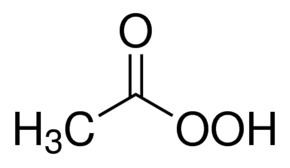Abbreviations PAA Density 1.04 g/cm³ Boiling point 25 °C Appearance Colorless liquid | Formula C2H4O3 Melting point 0 °C Molar mass 76.05 g/mol | |
 | ||
Gold recovery using peracetic acid white vinegar hydrogen peroxide
Peracetic acid (also known as peroxyacetic acid, or PAA), is an organic compound with the formula CH3CO3H. This organic peroxide is a colorless liquid with a characteristic acrid odor reminiscent of acetic acid. It can be highly corrosive.
Contents
- Gold recovery using peracetic acid white vinegar hydrogen peroxide
- Peracetic acid
- Production
- Uses
- Epoxidation
- Safety
- References
Peracetic acid is a weaker acid than the parent acetic acid, with a pKa of 8.2.
Peracetic acid
Production
Peracetic acid is produced industrially by the autoxidation of acetaldehyde:
O2 + CH3CHO → CH3CO3HIt forms upon treatment of acetic acid with hydrogen peroxide:
H2O2 + CH3CO2H ⇌ CH3CO3H + H2OAs an alternative, acetyl chloride and acetic anhydride can be used to generate a solution of the acid with lower water content.
Peracetic acid is generated in situ by some laundry detergents. This route involves the reaction of tetraacetylethylenediamine (TAED) in the presence of an alkaline hydrogen peroxide solution The peracetic acid is a more effective bleaching agent than hydrogen peroxide itself. PAA is also formed naturally in the environment through a series of photochemical reactions involving formaldehyde and photo-oxidant radicals.
Peracetic acid is always sold in solution with acetic acid and hydrogen peroxide to maintain the stability of the peracid. The concentration of the acid as the active ingredient can vary.
Uses
The United States Environmental Protection Agency first registered peracetic acid as an antimicrobial in 1985 for indoor use on hard surfaces. Use sites include agricultural premises, food establishments, medical facilities, and home bathrooms. Peracetic acid is also registered for use in dairy/cheese processing plants, on food processing equipment, and in pasteurizers in breweries, wineries, and beverage plants. It is also applied for the disinfection of medical supplies, to prevent biofilm formation in pulp industries, and as a water purifier and disinfectant. Peracetic acid can be used as a cooling tower water disinfectant, where it prevents bio film formation and effectively controls Legionella bacteria. A trade name for peracetic acid as an antimicrobial is Nu-Cidex.
Epoxidation
Although less active than more acidic peracids (e.g., m-CPBA), peracetic acid in various forms is used for the epoxidation of various alkenes. Useful application are for unsaturated fats, synthetic and natural rubbers, and some natural products such as pinene. A variety of factors affect the amount of free acid or sulfuric acid (used to prepare the peracid in the first place).
Safety
Peracetic acid is a strong oxidizing agent (E0 = 1.762 V vs Ag/AgCl) and a primary irritant. Exposure to peracetic acid can cause irritation to the skin, eyes and respiratory system and higher or long-term exposure can cause permanent lung damage. In addition, there have been cases of occupational asthma caused by peracetic acid. The ACGIH has published (spring 2014) a STEL TLV for peracetic acid of 0.4 ppm, calculated as a 15-minute time weighted average. Currently there is no OSHA Permissible Exposure Limit (PEL) for peracetic acid. In 2010, the US EPA published Acute Exposure Guidelines (AEGL) for peracetic acid.
